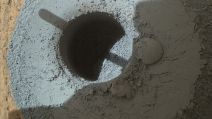NASA's Curiosity Rover discovers real color of Mars is greyish-blue

NASA's Curiosity rover has just discovered an intriguing fact about Mars - the Red Planet could actually be greyish-blue in color. During one of its drilling missions on Mars, the Curiosity rover discovered that the color of the soil a few inches below the planet's iron-rich surface was grayish-blue.
Curiosity rover has started digging at the third drilling site at Telegraph Peak on Mars to collect samples to be sent to its onboard laboratory. Researchers hope that the samples will help them understand how Mars, which is believed to have a similar appearance as Earth millions of years ago, turned dry and arid.
Researchers also hope to learn about the planet's history and the possibility of life on Mars, which is believed to be red due to the sprinkling of iron oxide all across its land. However, when the Curiosity rover scratched beneath Mars' surface, it found the color to be a combination of blue and grey. Images of the drill site on Mars released recently by NASA clearly show the soil underneath the planet's red surface to be pastel in color.
Similar to Earth, the planet Mars is made up of mostly silicon and oxygen and also contains significant amounts of iron, magnesium, aluminum, calcium and potassium. Nevertheless, NASA's scientists hardly expected to see the high amounts of silicon in the sample taken by the Curiosity rover at Telegraph Peak. Scientists believe that Mars' surface could have turned red after becoming exposed to oxygen, causing it to rust.
In its statement explaining the striking differences in the chemical make-up of the soil above and below Mars' surface, NASA said, "When you graph the ratios of silica to magnesium and silica to aluminum, 'Telegraph Peak' is toward the end of the range we've seen. It's what you would expect if there has been some acidic leaching. We want to see what minerals are present where we found this chemistry."